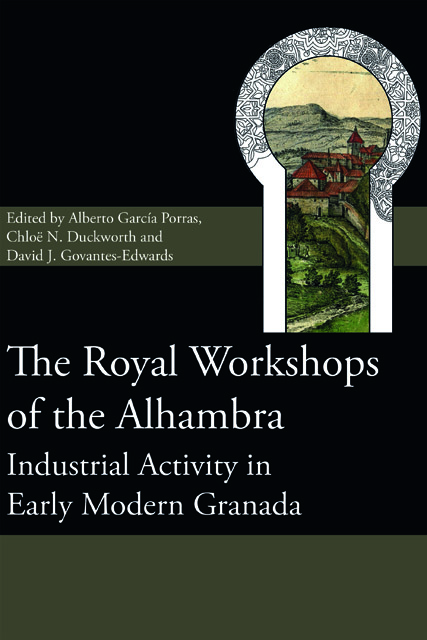Book contents
- Frontmatter
- Contents
- List of Illustrations
- List of Contributors
- Acknowledgements
- Foreword
- Introduction
- 1 The Secano: the city of the Alhambra
- 2 A holistic and reflexive methodology for the archaeological investigation of pyrotechnological activity in the Alhambra
- 3 The modern kilns
- 4 Geophysical and geochemical exploration of the industrial areas in the Alhambra
- 5 The excavation of the area of the Secano in the Alhambra: Trench 1
- 6 The excavation of the area of the Secano in the Alhambra: Trench 2
- 7 The pottery
- 8 Glass in the excavation of the Secano, the Alhambra
- 9 Furnaces at full blast: the demand for architectural ceramics for construction in the Alhambra (16th and 17th centuries)
- Conclusions
- Index
5 - The excavation of the area of the Secano in the Alhambra: Trench 1
Published online by Cambridge University Press: 20 December 2023
- Frontmatter
- Contents
- List of Illustrations
- List of Contributors
- Acknowledgements
- Foreword
- Introduction
- 1 The Secano: the city of the Alhambra
- 2 A holistic and reflexive methodology for the archaeological investigation of pyrotechnological activity in the Alhambra
- 3 The modern kilns
- 4 Geophysical and geochemical exploration of the industrial areas in the Alhambra
- 5 The excavation of the area of the Secano in the Alhambra: Trench 1
- 6 The excavation of the area of the Secano in the Alhambra: Trench 2
- 7 The pottery
- 8 Glass in the excavation of the Secano, the Alhambra
- 9 Furnaces at full blast: the demand for architectural ceramics for construction in the Alhambra (16th and 17th centuries)
- Conclusions
- Index
Summary
Trench 1 was situated in an area of the Secano where numerous furnace structures, most of which are likely dated to the 16th and 17th centuries, are preserved. The characteristics of these furnaces, however, are not immediately apparent, owing to the reconstructions erected over them in the 1960s and 1970s. These reconstructions did not follow even the most basic criteria for this sort of work, and it is often difficult to distinguish between the original features and the reconstruction. The excavation of this area, which is heavily landscaped, was also interesting because it had been previously excavated by the former director of the site, Francisco Prieto Moreno (also responsible for the reconstructions); however, no archaeological protocols were followed, and the extent and scope of the old excavation were unclear (no records, photographs, or plans exist), which posed some difficulties for the site in terms of heritage management. The excavation resulted in the improved characterization of one late medieval and several early modern furnaces, as well as the identification of a considerable number of production remains which, with the aid of archaeometric techniques, will shed light on potential technological changes in the production of glass and glazed ceramics between the final stages of the Nasrid period and the beginning of Christian rule, after the conquest of Granada by the Catholic Monarchs in 1492. The excavation of the furnaces was assisted by handheld portable X-ray Fluorescence (pXRF) analysis, which provided very valuable information concerning the distribution patterns of the elements used in ceramic glazing over the industrial area.
Keywords: pyrotechnologies; workshops; kiln; pottery; reuse.
Introduction
Trench 1, approximately 70m in size, was located in the eastern sector of the Secano, N of Calle Real de la Alhambra, near the modern tourist path. The trench was situated between several visible structures, which were non-scientifically restored in the early 1970s by Francisco Prieto Moreno and in principle identified as pottery kilns.
A total of four kilns flanked the trench on several sides, and the excavation led to the discovery of a succession of workshop areas, confirming that the area was used for industrial production without interruption from the Nasrid period to the 17th century.
- Type
- Chapter
- Information
- The Royal Workshops of the AlhambraIndustrial Activity in Early Modern Granada, pp. 73 - 84Publisher: Boydell & BrewerPrint publication year: 2022

